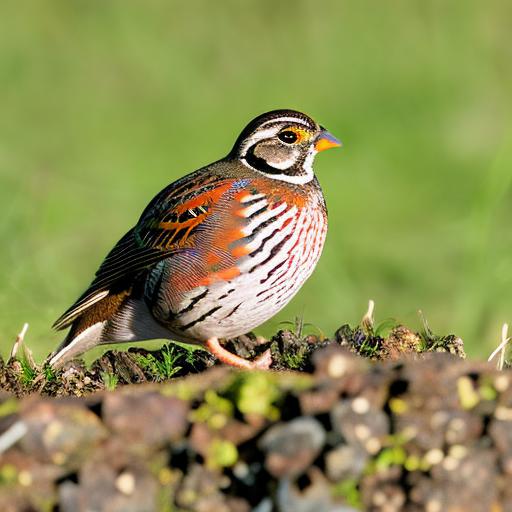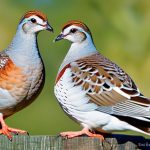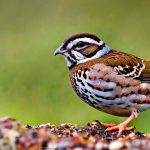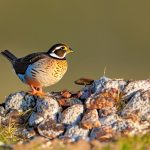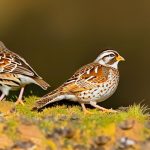Quail are small, ground-dwelling birds that are known for their distinctive calls and quick, darting movements. They are primarily found in grasslands, open woodlands, and agricultural areas, and are known for their ability to blend into their surroundings with their mottled brown and gray plumage. Quail are social birds that typically live in coveys, which are small groups of birds that forage and roost together. They are also known for their strong, direct flight and their ability to run quickly along the ground to escape predators.
In terms of habitat needs, quail require a mix of open areas for foraging and dense cover for nesting and roosting. They prefer areas with a variety of grasses, forbs, and shrubs, as well as access to water sources such as ponds, streams, or water troughs. Quail are also sensitive to disturbances and may be negatively impacted by activities such as intensive agriculture, urban development, and predation. Understanding the behavior and habitat needs of quail is essential for creating suitable habitat on your property and ensuring the long-term health and sustainability of quail populations.
Quail are also known for their seasonal movements, with some species migrating to warmer climates in the winter and returning to their breeding grounds in the spring. Understanding these seasonal movements can help landowners better manage their properties to provide suitable habitat for quail throughout the year. By understanding quail behavior and habitat needs, landowners can make informed decisions about habitat management, predator control, and other conservation efforts to support healthy quail populations on their properties.
Key Takeaways
- Quail are ground-dwelling birds that prefer open grasslands and shrubby areas for habitat.
- Creating suitable quail habitat on your property involves providing a mix of grasses, forbs, and shrubs for cover and nesting.
- Providing food and water sources for quail can include planting native grasses and forbs, and setting up water stations.
- Managing predators and threats to quail involves controlling predators like snakes, raccoons, and feral cats, and minimizing habitat destruction.
- Nesting and breeding considerations for quail include providing suitable nesting sites and minimizing disturbances during the breeding season.
Creating Suitable Quail Habitat on Your Property
Creating suitable habitat for quail on your property involves a combination of habitat management techniques, including providing food and water sources, managing vegetation, and controlling predators. One of the most important aspects of creating suitable quail habitat is providing a mix of open areas for foraging and dense cover for nesting and roosting. This can be achieved by maintaining a diverse mix of grasses, forbs, and shrubs, as well as creating brush piles and hedgerows to provide additional cover for quail.
In addition to managing vegetation, providing food and water sources is essential for supporting healthy quail populations. Planting native grasses and forbs can provide important food sources for quail, while maintaining water sources such as ponds, streams, or water troughs can ensure that quail have access to the water they need to survive. Landowners can also create food plots specifically designed to attract quail by planting a mix of native grasses, forbs, and legumes that provide important food sources throughout the year.
Managing predators is another important aspect of creating suitable quail habitat on your property. Predators such as foxes, raccoons, and snakes can pose a significant threat to quail populations, so implementing predator control measures such as trapping, fencing, or using guard animals can help reduce predation pressure on quail. By creating suitable habitat on your property and implementing habitat management techniques such as providing food and water sources, managing vegetation, and controlling predators, landowners can support healthy quail populations and contribute to the conservation of these iconic birds.
Providing Food and Water Sources for Quail
Providing food and water sources is essential for supporting healthy quail populations on your property. Quail are primarily ground-dwelling birds that forage for seeds, insects, and other small invertebrates in grasslands, open woodlands, and agricultural areas. Planting native grasses and forbs can provide important food sources for quail throughout the year, while maintaining water sources such as ponds, streams, or water troughs can ensure that quail have access to the water they need to survive.
Landowners can also create food plots specifically designed to attract quail by planting a mix of native grasses, forbs, and legumes that provide important food sources throughout the year. These food plots can be strategically located near dense cover to provide a safe feeding area for quail while also providing important food sources to support healthy quail populations. In addition to providing food sources, maintaining water sources such as ponds, streams, or water troughs is essential for ensuring that quail have access to the water they need to survive.
By providing food and water sources on your property, you can support healthy quail populations and contribute to the conservation of these iconic birds. Whether you are planting native grasses and forbs to provide important food sources or maintaining water sources such as ponds, streams, or water troughs to ensure that quail have access to the water they need to survive, providing food and water sources is essential for supporting healthy quail populations on your property.
Managing Predators and Threats to Quail
Managing predators and other threats is essential for supporting healthy quail populations on your property. Predators such as foxes, raccoons, snakes, and birds of prey can pose a significant threat to quail populations, so implementing predator control measures such as trapping, fencing, or using guard animals can help reduce predation pressure on quail. In addition to managing predators, controlling other threats such as habitat loss, fragmentation, and disturbances is also important for supporting healthy quail populations.
Habitat loss and fragmentation can occur as a result of activities such as intensive agriculture, urban development, and natural disasters, which can reduce the amount of suitable habitat available for quail. By implementing habitat management techniques such as maintaining a diverse mix of grasses, forbs, and shrubs and creating brush piles and hedgerows to provide additional cover for quail, landowners can help mitigate the impacts of habitat loss and fragmentation on quail populations. Minimizing disturbances such as off-road vehicle use, livestock grazing, and recreational activities can also help reduce stress on quail populations and support their long-term health and sustainability.
By managing predators and other threats such as habitat loss, fragmentation, and disturbances, landowners can support healthy quail populations on their properties and contribute to the conservation of these iconic birds. Whether you are implementing predator control measures such as trapping or fencing or managing habitat to reduce the impacts of habitat loss and fragmentation on quail populations, managing predators and other threats is essential for supporting healthy quail populations on your property.
Nesting and Breeding Considerations for Quail
Nesting and breeding considerations are essential for supporting healthy quail populations on your property. Quail typically nest on the ground in dense cover such as grasses, shrubs, or brush piles, so maintaining suitable nesting habitat is important for supporting successful breeding efforts. Landowners can create nesting habitat by maintaining a diverse mix of grasses, forbs, and shrubs and creating brush piles and hedgerows to provide additional cover for quail.
In addition to providing suitable nesting habitat, minimizing disturbances during the breeding season is also important for supporting successful breeding efforts. Disturbances such as off-road vehicle use, livestock grazing, and recreational activities can disrupt nesting activities and cause stress to breeding pairs, so minimizing disturbances during the breeding season can help support successful breeding efforts. By providing suitable nesting habitat and minimizing disturbances during the breeding season, landowners can support healthy quail populations on their properties and contribute to the conservation of these iconic birds.
Monitoring breeding efforts is also important for understanding population dynamics and identifying potential threats to breeding success. Landowners can monitor breeding efforts by conducting regular surveys to count coveys and identify nesting sites, as well as monitoring chick survival rates to assess breeding success. By monitoring breeding efforts and identifying potential threats to breeding success, landowners can make informed decisions about habitat management, predator control, and other conservation efforts to support healthy quail populations on their properties.
Monitoring and Observing Quail Populations
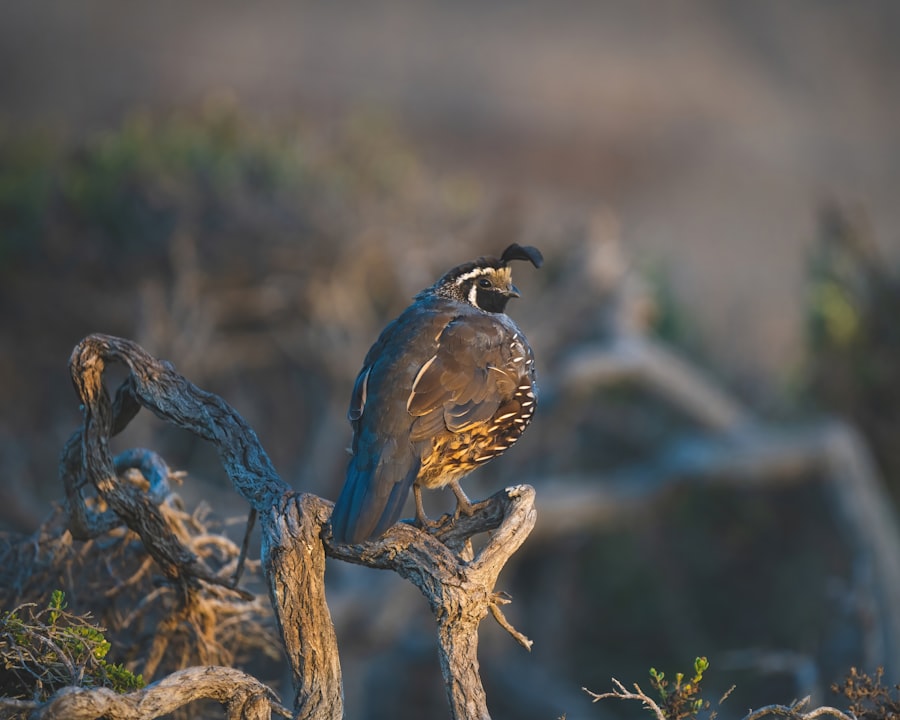
Monitoring and observing quail populations is essential for understanding population dynamics and identifying potential threats to quail populations on your property. Landowners can monitor quail populations by conducting regular surveys to count coveys and identify nesting sites, as well as monitoring chick survival rates to assess breeding success. By monitoring quail populations over time, landowners can gain valuable insights into population trends and make informed decisions about habitat management, predator control, and other conservation efforts.
Observing quail behavior is also important for understanding population dynamics and identifying potential threats to quail populations. By observing quail behavior in their natural habitat, landowners can gain valuable insights into their daily activities, seasonal movements, and interactions with other wildlife species. This information can help landowners better understand the behavior and habitat needs of quail and make informed decisions about habitat management, predator control, and other conservation efforts.
By monitoring and observing quail populations on your property, you can gain valuable insights into population dynamics and make informed decisions about habitat management, predator control, and other conservation efforts. Whether you are conducting regular surveys to count coveys or observing quail behavior in their natural habitat, monitoring and observing quail populations is essential for supporting healthy quail populations on your property.
Conservation and Legal Considerations for Keeping Quail
Conservation and legal considerations are important for keeping quail on your property. Quail are protected under various state and federal laws that regulate hunting seasons, bag limits, possession limits, and other aspects of hunting activities. It is important for landowners to be aware of these laws and regulations when managing their properties for quail hunting or conservation purposes.
In addition to legal considerations, conservation efforts are also important for supporting healthy quail populations on your property. Landowners can contribute to conservation efforts by creating suitable habitat for quail through habitat management techniques such as providing food and water sources, managing vegetation, controlling predators, and minimizing disturbances. By supporting conservation efforts on your property, you can help ensure the long-term health and sustainability of quail populations in your area.
Engaging with local conservation organizations and wildlife agencies can also provide valuable resources and support for keeping quail on your property. These organizations can provide guidance on habitat management techniques, predator control measures, monitoring protocols, and other aspects of managing your property for quail conservation purposes. By working with these organizations, landowners can gain valuable insights into best practices for supporting healthy quail populations on their properties.
In conclusion, understanding the behavior and habitat needs of quail is essential for creating suitable habitat on your property. By providing food and water sources, managing predators and other threats, considering nesting and breeding considerations, monitoring and observing populations, as well as understanding conservation laws are all crucial aspects of keeping healthy quails on your property.
If you’re interested in raising quail on your property, you might also want to learn about the mating season for ducks. Understanding the breeding habits of different poultry can help you create a more efficient and successful farming operation. Check out this informative article on duck mating season to expand your knowledge and improve your overall poultry management skills.
FAQs
What are the benefits of keeping quail on your property?
Quail can help control insect populations, provide entertainment and education, and potentially serve as a food source.
What type of housing do quail need?
Quail require a secure and predator-proof enclosure, such as a coop or aviary, with proper ventilation and protection from the elements.
What do quail eat?
Quail primarily eat a diet of seeds, grains, and insects. It’s important to provide them with a balanced commercial quail feed as well as access to fresh water.
How do you care for quail?
Quail require regular feeding, access to clean water, and a clean living environment. They also need protection from predators and proper healthcare, including vaccinations and parasite control.
Are there any legal considerations for keeping quail on your property?
It’s important to check local regulations and zoning laws to ensure that keeping quail is allowed on your property. Some areas may have restrictions on the number of quail you can keep or require permits.
Can quail be kept with other animals?
Quail can coexist with other poultry, but it’s important to provide separate housing and ensure that they are not bullied or harassed by other animals.
What are some common health issues for quail?
Common health issues for quail include respiratory infections, parasites, and injuries from predators or other animals. Regular health checks and proper hygiene can help prevent these issues.
Meet Walter, the feathered-friend fanatic of Florida! Nestled in the sunshine state, Walter struts through life with his feathered companions, clucking his way to happiness. With a coop that’s fancier than a five-star hotel, he’s the Don Juan of the chicken world. When he’s not teaching his hens to do the cha-cha, you’ll find him in a heated debate with his prized rooster, Sir Clucks-a-Lot. Walter’s poultry passion is no yolk; he’s the sunny-side-up guy you never knew you needed in your flock of friends!

